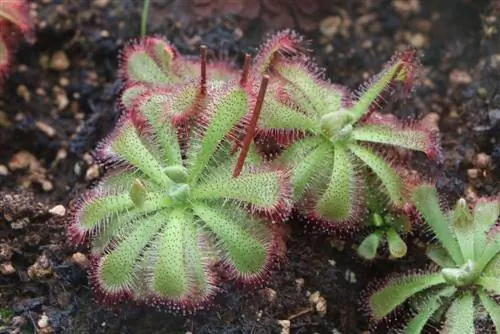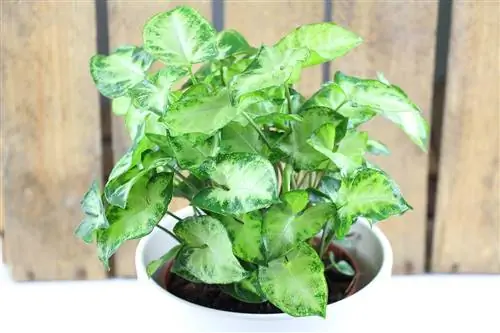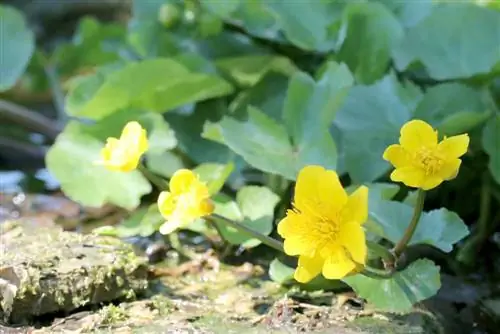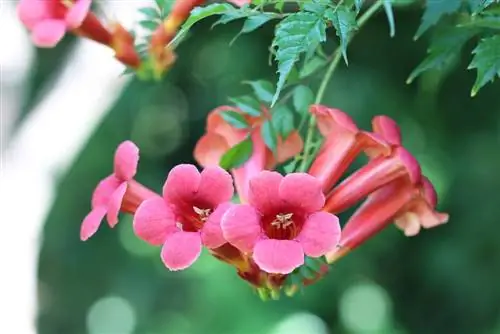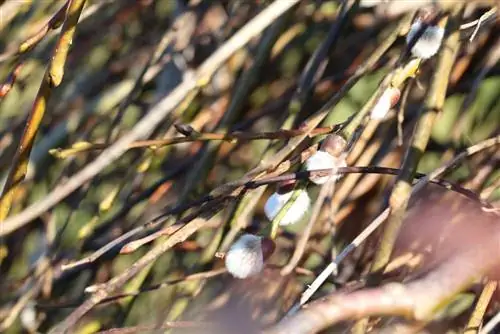- Author admin [email protected].
- Public 2023-12-17 03:39.
- Last modified 2025-06-01 06:48.
The sundew genus surrounds itself with the aura of a superlative ornamental plant. The ingenious survival artists use movable, mysteriously shimmering blades to catch prey. Drosera thrive in almost all climates, so no carnivore lover will be left empty-handed when it comes to choosing indoors and outdoors. Get to know the most beautiful sundew species here. These instructions for professional care provide practical tips for successful propagation and overwintering.
Beautiful species - a selection
Botanists divide the almost 200 sundew species into a total of 5 groups. The classification is based primarily on the distribution area and the growth habit. Three groups are of particular interest to hobby gardeners because the Drosera included are suitable for cultivation as house or garden plants: subtropical/tropical and winter-hardy growth forms as well as dwarf Drosera. The following idea of beautiful species follows this classification:
Subtropical and tropical sundew species
Drosera capensis - Cape Sundew
One of the most popular sundew species for the windowsill is native to South Africa. Drosera capensis is extremely easy to care for and perfect for beginners. The narrow leaves form a rosette with a diameter of 18 to 25 cm. In winter, pale purple flower clusters rise up to 35 cm above the rosette of leaves.
- Growth height: 10 to 20 cm, at flowering time 30 to 35 cm
- Flowering time: December to January
Drosera aliciae
Together with Drosera capensis, Drosera aliciae forms the ideal duo for carnivore beginners. The South African sundew species forms a 5 cm small, prostrate rosette with leaves up to 3 cm long. During the flowering period, a flower stalk up to 40 cm high with terminal pink flowers rises spectacularly.
- Growth height: 10 to 15 cm, at flowering time up to 40 cm
- Flowering time: December to January
Drosera regia
The queen of the sundew plants boasts a majestic shape and leaves up to 40 cm long. Their white to red-black tentacles are 3 mm long, meaning that the most powerful Drosera species also captures large flies. The 5-petaled flowers shine in an intense purple and are equipped with sticky glands for catching insects.
- Growth height: 50 to 100 cm
- Flowering period: January to February
Hardy Drosera species
Drosera rotundifolia - round-leaved sundew
The German name refers to the round-shaped leaves, which in this species gather to form a decorative rosette. The horizontally extended leaves are covered with up to 200 reddish tentacles. In full sun, the carnivore boasts clusters of white flowers in summer, which unfold at a safe distance from the sticky leaves.
- Growth height: 5 to 20 cm, at flowering time 30 to 35 cm
- Flowering period: June to August
Drosera anglica - Long-leaved Sundew
With its up to 10 cm long fang leaves and reddish tentacles, this Drosera is a feast for the eyes when the sunlight is refracted in the sugary secretion. The five-fold, white flowers are arranged like a wrap on the flower stem and open alternately on the right and left.
- Growth height: 10 to 20 cm, at flowering time up to 30 cm
- Flowering time: June and July
Dwarf sundew species
Drosera Scorpioides
One of the most fascinating dwarf Drosera impresses with its trapping leaves that are reminiscent of the poisonous tail of a scorpion. The popular species is native to Australia and forms rosettes with a diameter of 3.5 cm. The white or pink flowers make the tiny carnivore an unmissable highlight on the sunny windowsill.
- Growth height: up to a maximum of 10 cm
- Flowering time: in summer
Drosera roseana
The distinctive Drosera roseana has already paved the way for numerous hobby gardeners to become carnivores. The delicate rosette of leaves reaches a diameter of 3 to 5 cm. Depending on the incidence of light, the leaves change color to yellow-green, pink or dark red. At 1 cm, the flowers are comparatively large and delight in white, red or orange shades.
- Growth height: 3 cm, at flowering time up to 5 cm
- Flowering period: November to January
Care instructions
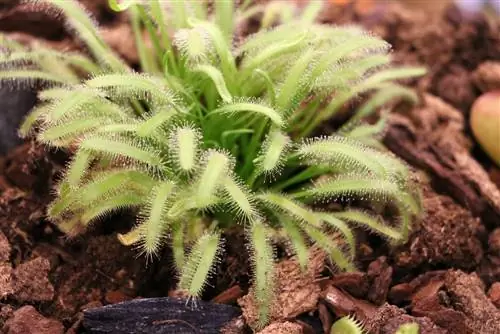
General care instructions do not do justice to the broad species spectrum of the cosmopolitan sundew genus. This guide therefore differentiates between cold-sensitive and winter-hardy Drosera. The focus is primarily on those species whose cultivation can be successfully managed even by beginners.
Tropical and subtropical species in indoor culture
Location
Drosera species from the tropical belt are extremely light-hungry and yet not sun worshipers. The choice of location therefore plays a key role in professional care. The following light and temperature conditions promote the growth and vitality of indoor sundews:
- Very bright to sunny location with a light intensity of 75 to 90 percent
- Ideally with summer light filtering through a thin curtain or a deciduous tree in front of the window
- In summer or all year round temperatures of at least 22 degrees Celsius, preferably up to over 30 degrees Celsius
During the warm season, sundew plants like to enjoy the sunlight outdoors. A location on the sunny balcony is therefore very welcome for Drosera species, as long as the mercury column does not fall below 18 degrees Celsius, even at night. Like all plants that overwinter behind glass, your carnivores should first acclimatize in a partially shaded location for 8 to 14 days. Suddenly moving into direct sunlight can cause burns on the leaves.
Substrate
Low in nutrients, acidic, loose and good water retention are the most important attributes for the perfect substrate. Commercially available flower or bog soil is far from meeting the quality requirements. For successful cultivation of sundews, we recommend special carnivore soil from specialist retailers.
Pouring
The roots of Drosera are sensitive to lime. The use of special carnivore soil is not enough to address the aversion to lime. Therefore, use primarily collected rainwater for watering so that limescale does not accumulate in the substrate via the water supply route. How to properly water sundew on the windowsill:
- Keep the potting soil constantly slightly moist
- Watere regularly and abundantly from spring to autumn
- Do not allow the substrate surface to dry between waterings
Sundew is one of the few houseplants that want a moist base. Therefore, let the irrigation water run onto the soil until the saucer fills up. Only when the accumulated water has evaporated or been utilized do you water again.
Tip:
Are you lacking options to collect rainwater for your sundew plants? Then water the carnivores with a mixture of distilled water and stale tap water in a ratio of 10: 1.
Humidity
High humidity is one of the mainstays of a professional care program. Spray sundews with lime-free water every 1 to 2 days. In addition, please position humidifiers in the immediate vicinity of the houseplants all year round. A coaster filled with pebbles and water is beneficial for the local humidity.
Feeding
The special appeal of carnivores is that they do not get their nutrients from conventional fertilizers. Fertilizing is therefore not part of the sundew care program. Rather, the movable trapping leaves serve to capture insects with their sticky, sugary tentacles. If a prey animal has become entangled, all tentacles in the immediate vicinity lean over it to strengthen the hold. With the help of digestive enzymes, the victim is decomposed and the nutrients it contains are assimilated. The trapping leaves then stand up again, release the meager remains and start hunting again.

Prey insects, such as fungus gnats, are usually present in sufficient numbers in living spaces and fully cover the needs of carnivores. There is therefore no need to specifically feed sundews. If you would like to experience the fascinating process live, capture a small fly or mosquito and give the insect live food.
Wintering
You can cultivate all sundew plants suitable for indoor cultivation on the bright, warm windowsill all year round. A winter rest period is beneficial for vitality and durability. By overwintering tropical, subtropical and dwarf Drosera using the following method, you can mitigate the effects of the Central European winter climate:
- Spend in a cool, bright location from October to March
- Temperatures from 8 to 12 degrees Celsius for subtropical species
- Temperatures of 15 to 20 degrees Celsius for tropical species
- Compensate for a lack of light with a plant lamp
- Watering more sparingly without letting the substrate dry out
An air humidity of more than 50 percent is of central importance during the winter. Above all, wintering in heated rooms should always be accompanied by the recommended precautions for increasing the air humidity.
European species - care in the bed and on the balcony
Only a few hikers are privileged to admire one of the three native sundew species in fields and forests. The spectacular trappers are threatened with extinction and are protected. By purchasing hardy Drosera from specialist retailers and cultivating them in your garden, you will receive sensational eye-catchers and at the same time make a valuable contribution to the preservation of floral rarities. As these care instructions show, the carnivorous perennials are characterized by modest demands.
Location
A full sun to sunny location in the moorland offers native sundew species the perfect conditions. A large mortar tray that can be converted into a moor bed is suitable for cultivation on the balcony. Normal garden soil and calcareous substrate are taboo. Use pure sphagnum or a mix of peat and lime-free sand to plant the hardy Drosera in.
Pouring
European sundew plants favor a permanently moist, acidic environment. Therefore, water the carnivores abundantly and regularly with rainwater. The moorland soil must not dry out or even dry out.
Fertilize
Winter-resistant Drosera for garden beds and balconies do not receive any fertilizer. The carnivorous plants get their nutrients from the captured insects, which there is no shortage of in the wild.
Wintering
A characteristic feature of hardy sundew plants is the formation of a winter bud, known in technical jargon as a hibernacle. The carnivores retreat there in autumn and winter and sprout fresh from April and May. Biting frost doesn't cause any problems for the robust perennials. In dry winters, however, there is a risk of failures. Please continue the water supply seamlessly during the winter rest period, provided there is no snow or rain.
Propagate sundew species
There are three methods to choose from for propagating Drosera, which can be achieved using simple means:
Leaf cuttings
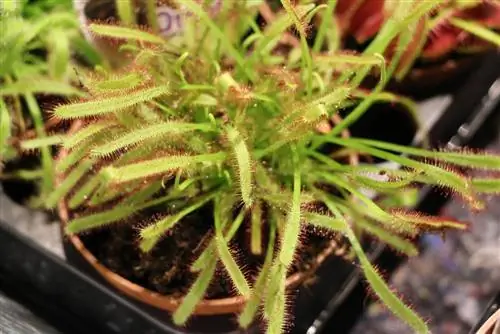
The best time for vegetative propagation with leaf cuttings is during the growth phase. You can propagate sundew species that do not hibernate all year round using this method. The procedure is uncomplicated and scores with a low failure rate. How to proceed step by step:
- Using a sharp, disinfected knife, cut off a 4 cm long leaf
- Fill a pot or propagation tray with carnivore soil
- Spray the substrate with room temperature, lime-free water
- Place the leaf cuttings horizontally on the substrate with the tentacles facing up
Press the cuttings lightly to ensure a good connection to the soil. Within a few weeks, young sundew plants will sprout in the partially shaded, warm window seat.
Root cuttings
The long root strands of numerous Drosera species are ideal for vegetative propagation. The procedure is similar to breeding using leaf cuttings. It is important to note that you leave at least 2 roots on the mother plant so that it does not die. The root cuttings are covered with a 1 to 2 cm thin layer of substrate, which you should spray regularly with rainwater.
Sowing seeds
In contrast to vegetative propagation through leaf cuttings and root cuttings, the result of generative sowing of seeds is unpredictable. The advantage of this method is the large number of young plants that you can grow this way. This is how it works:
- Fill the seed tray with carnivore soil and spray with soft water
- Spread seeds thinly
- Press lightly with a board
- Do not cover sundew seeds with substrate as light germinators
In a partially shaded, warm location, please keep the soil constantly slightly moist. By covering the seed container with a glass plate, you create a warm, humid microclimate that increases the seeds' mood for germination. When the first sundew seedlings sprout, the cover has done its job. The development from seed to adult sundew plant takes up to 12 months.

